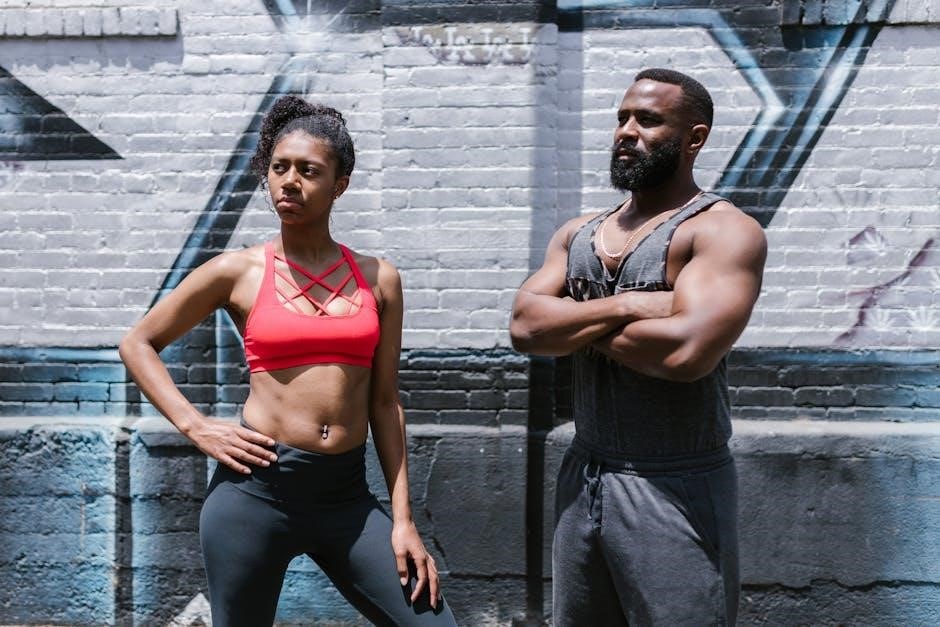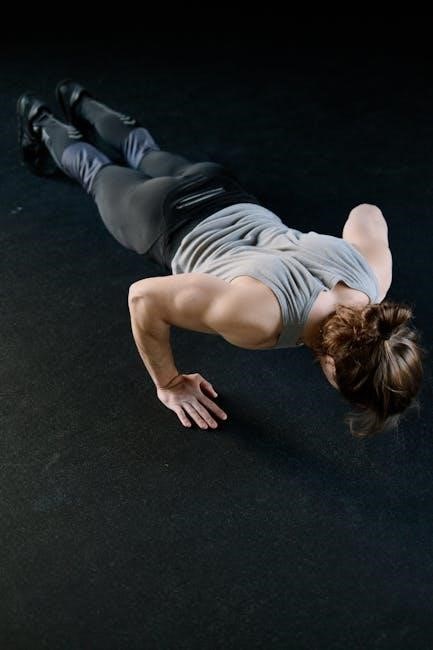bodyweight workout pdf
A bodyweight workout is an effective way to improve physical fitness without equipment, suitable for all fitness levels. This guide provides a structured plan to help you stay consistent and achieve your goals.
1.1 What is a Bodyweight Workout?
A bodyweight workout is a form of exercise that uses an individual’s own weight as resistance to build strength, endurance, and flexibility. It eliminates the need for gym equipment, making it accessible anywhere. Bodyweight exercises, such as push-ups, squats, and planks, engage multiple muscle groups simultaneously, promoting efficient and balanced fitness. This type of training is versatile, suitable for beginners and advanced individuals alike, and can be modified to suit different fitness levels. It enhances muscular strength, improves cardiovascular health, and boosts metabolism. Bodyweight workouts are popular due to their convenience, cost-effectiveness, and ability to deliver results without specialized gear. They are ideal for those seeking a sustainable and practical approach to staying fit.
1.2 Importance of a Workout Plan
A well-structured workout plan is essential for achieving fitness goals efficiently. It ensures consistency, helping individuals stay on track and avoid unnecessary setbacks. A plan provides clarity on exercises, sets, and repetitions, making workouts more focused and productive. It also promotes balanced muscle development by targeting different muscle groups systematically. Without a plan, it’s easy to overtrain or undertrain, leading to plateaus or injuries. A workout plan also enhances accountability, keeping you motivated to show up and perform. By incorporating the FITT Principle (Frequency, Intensity, Time, Type), a plan tailors workouts to individual needs, ensuring progressive overload for continuous improvement. Tracking progress becomes easier, allowing adjustments to maintain challenge and avoid stagnation. Ultimately, a workout plan serves as a roadmap to success, helping you maximize results and stay committed to your fitness journey.
1.3 Benefits of a PDF Guide
A bodyweight workout PDF guide offers numerous benefits for individuals seeking to improve their fitness. It serves as a comprehensive resource, providing structured routines, exercise descriptions, and progress tracking. The portability of a PDF allows users to access their workout plan anytime, anywhere, without needing internet connectivity. It also enables personalization, as users can easily print or annotate the guide to suit their preferences. A PDF guide ensures consistency, helping individuals stay organized and motivated throughout their fitness journey. Additionally, it often includes visual examples and tips, making it easier to understand and perform exercises correctly. By having a clear roadmap, users can avoid confusion and stay focused on their goals. This convenience and accessibility make a bodyweight workout PDF an invaluable tool for achieving and maintaining physical fitness.

Structure of a Bodyweight Workout Plan
A well-structured bodyweight workout plan is essential for effectiveness. It includes setting clear goals, understanding the FITT principle, and organizing exercises by muscle groups for optimal results and progression.
2.1 Understanding the FITT Principle
The FITT Principle—Frequency, Intensity, Time, and Type—is a foundational framework for structuring effective workouts. Frequency refers to how often you exercise, aiming for 3-5 sessions per week. Intensity involves challenging yourself, such as modifying push-ups to knee or decline variations. Time dictates session duration, typically 45-60 minutes, while Type focuses on exercise selection, like upper body or core workouts. Balancing these elements ensures a well-rounded routine. The FITT Principle also allows for progressive overload, helping you advance over time; By tailoring these components to your goals, you can maximize results and stay motivated. This approach ensures workouts are efficient, targeted, and adaptable to your fitness level.
2.2 Creating a Balanced Routine
A balanced bodyweight workout routine ensures overall fitness by targeting all major muscle groups. It combines upper body exercises like push-ups and pull-ups, lower body moves such as squats and lunges, and core-strengthening exercises like planks. Incorporating full-body workouts, such as burpees or mountain climbers, enhances coordination and burns calories. A well-structured routine alternates between strength and cardio-focused days to avoid overtraining. Proper warm-up and cool-down sessions are essential for injury prevention. Aim for 45-60 minutes per session, adjusting intensity and volume based on fitness levels. Consistency is key, so schedule workouts on non-consecutive days to allow recovery. This balanced approach ensures sustainable progress, prevents plateaus, and keeps workouts engaging. Tailor the routine to your goals, whether building muscle, improving endurance, or weight loss. Regular adjustments will help maintain motivation and track progress effectively.
Organizing exercises by muscle group ensures targeted development and prevents overtraining. Start with compound movements like push-ups and squats, which engage multiple muscle groups. For upper body, focus on chest, shoulders, and triceps with exercises like push-ups and dips. Back and biceps can be targeted with pull-ups and inverted rows. Lower body workouts emphasize squats, lunges, and glute bridges to build strong legs. Core exercises like planks, Russian twists, and leg raises improve stability and balance. Organizing workouts by muscle group allows for efficient training and recovery. Alternate between upper and lower body days, incorporating full-body exercises for variety. This approach ensures a comprehensive workout, prevents muscle imbalances, and maximizes results. By structuring routines this way, you can achieve a balanced physique and maintain long-term fitness goals effectively. This method is both efficient and adaptable to different fitness levels. Bodyweight exercises are versatile and effective for building strength and endurance. Compound movements like push-ups, squats, and lunges target multiple muscle groups, enhancing overall fitness efficiently. Upper body exercises are essential for building strength and definition in the chest, shoulders, and arms. Push-ups are a cornerstone, targeting the chest, shoulders, and triceps. Variations like wide-grip or diamond push-ups can emphasize different muscle groups. Pull-ups are another powerful exercise, though they require access to a bar. For those without equipment, inverted rows using a sturdy object can be an effective alternative. Planks and their variations, such as up-downs, engage the core and improve overall stability. Dips, performed on parallel bars or even a sturdy chair, effectively target the triceps and chest. Tricep dips are particularly useful for isolating the triceps. Proper form and technique are crucial to avoid injury and maximize results. Consistency and progressive overload will yield noticeable improvements in strength and muscle tone. Lower body exercises are fundamental for building strength, endurance, and mobility in the legs and hips. Squats are a foundational movement, targeting the quadriceps, hamstrings, and glutes. Lunges, whether walking or stationary, improve balance and isolate muscle groups. Glute bridges are excellent for activating the glutes and strengthening the posterior chain. Calf raises, both seated and standing, target the lower legs. Side lunges and step-ups (using a sturdy object or stairs) enhance lateral strength and coordination. Pistol squats, while challenging, offer a great way to build single-leg strength. Plank jacks and mountain climbers are dynamic exercises that combine cardio with leg training. Proper form is crucial to prevent injury, especially in exercises like squats and lunges. Consistency and gradual increases in difficulty will lead to noticeable improvements in lower body strength and overall athleticism. Core and full-body exercises are essential for improving overall stability, balance, and functional strength. Planks are a cornerstone, engaging the abs, obliques, and lower back. Push-ups target the chest, shoulders, and triceps while incorporating core stability. Bicycle crunches and Russian twists specifically target the obliques, enhancing rotational strength. Burpees are a dynamic full-body exercise that combines strength and cardio, working the arms, legs, and core. Mountain climbers add a plyometric element, boosting heart rate while engaging the core. Superman holds and bird dogs improve posture and strengthen the lower back. For full-body conditioning, consider squat thrusters, jump squats, and tuck jumps. These exercises promote coordination and burn calories efficiently. Incorporating variations like single-leg planks or plyometric push-ups can challenge advanced individuals. Always focus on proper form to prevent injury and maximize results. These exercises create a well-rounded routine that enhances both strength and endurance. Focus on proper form and technique to prevent injuries and optimize results. Incorporate progressive overload by increasing reps or intensity over time. Stay consistent and motivated by setting achievable goals. Proper form and technique are essential for maximizing the effectiveness of bodyweight workouts while minimizing injury risk. Maintaining correct posture and movement ensures that the intended muscles are targeted efficiently. Poor form can lead to injuries or reduced results. For example, in push-ups, keeping the core engaged and avoiding sagging hips is crucial. Similarly, during squats, tracking knees over toes and lowering to a safe depth prevents strain. Paying attention to these details enhances the workout’s impact and promotes long-term progress. By mastering form, you can safely challenge yourself and achieve better overall fitness outcomes. Consistency in proper technique also builds strength and confidence, making workouts more productive and enjoyable. Always prioritize quality over quantity to reap the full benefits of bodyweight exercises. Progressive overload is a key principle for continuous improvement in bodyweight training. It involves gradually increasing the intensity of workouts to challenge muscles and promote growth. This can be achieved by adding more repetitions, sets, or reducing rest periods between exercises. For example, advancing from a standard push-up to a decline or single-arm push-up increases difficulty. Another method is slowing down movements or introducing pauses, such as in squats or lunges, to enhance muscle engagement. Incorporating variations like plyometric exercises, such as jump squats, also elevates intensity. Tracking progress and adjusting routines ensures consistent improvement. Progressive overload prevents plateaus and keeps workouts engaging, helping you build strength and endurance over time. By systematically increasing demands, you can achieve long-term fitness goals and maintain motivation. This approach ensures your workouts remain effective and challenging. Consistency and motivation are crucial for achieving long-term success in bodyweight training. Setting realistic goals helps maintain focus, while celebrating milestones boosts morale. Tracking progress through a workout journal or fitness app enhances accountability and motivation. Exercising with friends or joining a community can make routines more enjoyable and encourage adherence. Listening to music or watching a TV show during workouts can also make them more engaging. Incorporating variety in exercises prevents boredom and keeps routines fresh. Remembering the benefits of regular exercise, such as improved energy and health, reinforces commitment. Staying motivated requires a balanced approach, combining discipline with enjoyment. By finding joy in the process and staying consistent, you can maintain a sustainable and effective bodyweight workout routine. Over time, this consistency will yield lasting results and a stronger connection to your fitness journey. Safety is key to an effective bodyweight workout. Always warm up, use proper form, and listen to your body to prevent injuries. Avoid overexertion and seek professional guidance if needed. A proper warm-up is essential to prepare your body for a bodyweight workout, reducing the risk of injury and improving performance. Start with 5-10 minutes of light cardio, such as jumping jacks or jogging in place, followed by dynamic stretches like arm circles and leg swings. This increases blood flow and flexibility. After your workout, cool down with static stretches to relax your muscles and improve recovery. Include stretches for major muscle groups, holding each for 20-30 seconds. Deep breathing exercises can also help reduce stress and promote relaxation. A consistent warm-up and cool-down routine ensures safer workouts and enhances overall results. Always prioritize proper form and technique to avoid strain. These routines are crucial for long-term fitness and injury prevention. Listening to your body is crucial for a safe and effective bodyweight workout. Pay attention to signs of fatigue, pain, or discomfort, as ignoring them can lead to injuries. Rest days are essential for muscle recovery and growth, so schedule them into your routine. If you feel overly exhausted, consider modifying exercises or reducing intensity. Proper hydration and nutrition also play a role in how your body responds to workouts. Stay attuned to your mental state as well—exercise should energize, not drain you. By honoring your body’s signals, you can maintain consistency and avoid burnout. This mindful approach ensures long-term progress and overall well-being. Always prioritize recovery to enhance performance and achieve your fitness goals safely. Common injuries in bodyweight workouts include muscle strains, joint pain, and overuse injuries. These often occur due to poor form, overexertion, or insufficient warm-ups. To prevent injuries, focus on proper technique and gradually increase intensity. Warm-up routines should include dynamic stretches to prepare muscles and joints. Strengthening core muscles can improve stability and reduce strain on vulnerable areas like the lower back and knees. Listening to your body and resting when needed is crucial to avoid overtraining. Additionally, incorporating flexibility exercises can enhance mobility and reduce injury risk. By prioritizing form and pacing, you can minimize the likelihood of common injuries and maintain a safe, effective workout routine. Prevention strategies ensure longevity in your fitness journey and overall well-being. Consistency paired with caution leads to sustainable progress. Proper nutrition, hydration, and recovery techniques are essential for muscle repair and energy replenishment, ensuring optimal performance and progress in bodyweight training. A balanced diet is crucial for optimizing bodyweight training results. It ensures adequate energy levels, supports muscle recovery, and helps maintain overall health. A well-structured meal plan should include a mix of proteins, carbohydrates, and fats to fuel workouts and promote muscle growth. Protein is particularly important for repairing and building muscle tissue, while carbohydrates provide the energy needed for intense sessions. Additionally, proper hydration is essential for performance and recovery. Avoiding excessive processed foods and maintaining a caloric intake that aligns with your goals (whether weight loss, maintenance, or gain) is key. Timing meals around workouts can also enhance results, with pre- and post-workout nutrition playing significant roles. A disciplined dietary approach, combined with consistency, will maximize the effectiveness of your bodyweight training routine. Staying hydrated is essential for optimal performance in bodyweight training. Water makes up a significant portion of muscle tissue and is vital for physical functions, including energy production and thermoregulation. Even mild dehydration can lead to fatigue, dizziness, and decreased focus, all of which can hinder workout effectiveness. Proper hydration supports muscle recovery, reducing soreness and improving overall performance. Aim to drink 8-10 glasses of water daily, adjusting for activity levels and climate. Additionally, consuming water before, during, and after workouts is recommended to maintain fluid balance. Avoid sugary drinks and opt for water or electrolyte-rich beverages to replenish lost salts. Monitoring urine color can help gauge hydration levels—pale yellow indicates proper hydration. Prioritizing hydration ensures your body functions efficiently, supporting both training and recovery. Proper recovery is crucial for maximizing the benefits of bodyweight training. Techniques like stretching, foam rolling, and rest days help muscles repair and grow stronger. Incorporating activities such as yoga or light cardio can enhance flexibility and reduce muscle tension. Additionally, ensuring adequate sleep and maintaining a balanced diet are vital for recovery. Hydration plays a key role in flushing out toxins and replenishing fluids lost during workouts. Overtraining can lead to injury or burnout, so listening to your body and allowing time for recovery is essential. By prioritizing recovery, you can optimize your workout results and maintain long-term consistency in your fitness journey. Tracking progress through goals, journals, and milestones helps maintain motivation. Celebrate achievements and adjust routines to stay engaged and committed to your bodyweight workout journey. Setting realistic goals is essential for maintaining motivation and tracking progress in your bodyweight workout journey. Start by assessing your current fitness level and defining achievable objectives. Use the SMART goal framework: Specific, Measurable, Achievable, Relevant, and Time-bound. Break larger goals into smaller, manageable milestones to avoid discouragement. For example, aim to complete a certain number of push-ups or hold a plank for a specific duration. Regularly review and adjust your goals based on progress. Celebrate small victories to stay motivated and remind yourself why these goals matter. Incorporate tools like a workout journal to track improvements and identify areas for growth. By setting clear, realistic targets, you create a roadmap for success and ensure long-term commitment to your bodyweight training. This structured approach helps maintain focus and fosters a sense of accomplishment. A workout journal is a powerful tool for tracking your bodyweight workout progress and staying accountable. By documenting each session, you can monitor exercises, sets, reps, and improvements over time. This helps identify patterns and areas for growth. Start by recording the date, exercises performed, and any modifications made. Note your performance metrics, such as time completed or difficulty level. Additionally, include how you felt during and after the workout to gauge recovery and intensity. Over time, this data will reveal progress and motivate you to push further. Use the journal to reflect on what works and adjust your routine accordingly. Celebrate milestones and use the insights to refine your approach. Consistently updating your journal fosters discipline and helps maintain a consistent workout routine. It’s a simple yet effective way to enhance your bodyweight training journey. Celebrating milestones is a crucial part of maintaining motivation in your bodyweight workout journey. Recognizing your achievements, no matter how small, helps build confidence and reinforces consistent effort. Set specific, achievable goals and reward yourself when you reach them—whether it’s treating yourself to new workout gear or taking a rest day to relax. Sharing your progress with friends or a fitness community can also boost motivation and accountability. Tracking improvements in strength, endurance, or physique over time serves as a powerful reminder of your hard work. Stay positive by focusing on the journey rather than perfection, and remind yourself why you started. Celebrating milestones not only reinforces discipline but also keeps the process enjoyable and sustainable in the long term.2.3 Organizing Exercises by Muscle Group
Effective Bodyweight Exercises
3.1 Upper Body Exercises
3.2 Lower Body Exercises
3.3 Core and Full-Body Exercises
Tips for Maximizing Workout Effectiveness
4.1 Importance of Form and Technique
4.2 Incorporating Progressive Overload
4.3 Staying Consistent and Motivated

Safety and Injury Prevention
5.1 Warm-Up and Cool-Down Routines
5.2 Listening to Your Body
5.3 Common Injuries and Prevention

Nutrition and Recovery
6.1 Role of Diet in Bodyweight Training
6.2 Importance of Hydration
6.3 Recovery Techniques for Better Results

Tracking Progress and Staying Motivated
7.1 Setting Realistic Goals
7.2 Using a Workout Journal
7.3 Celebrating Milestones and Staying Motivated